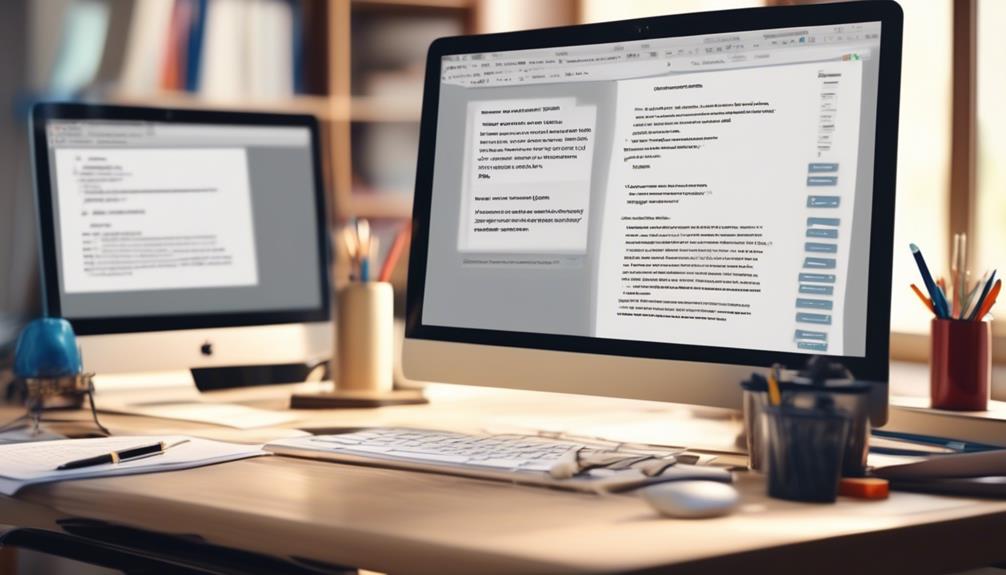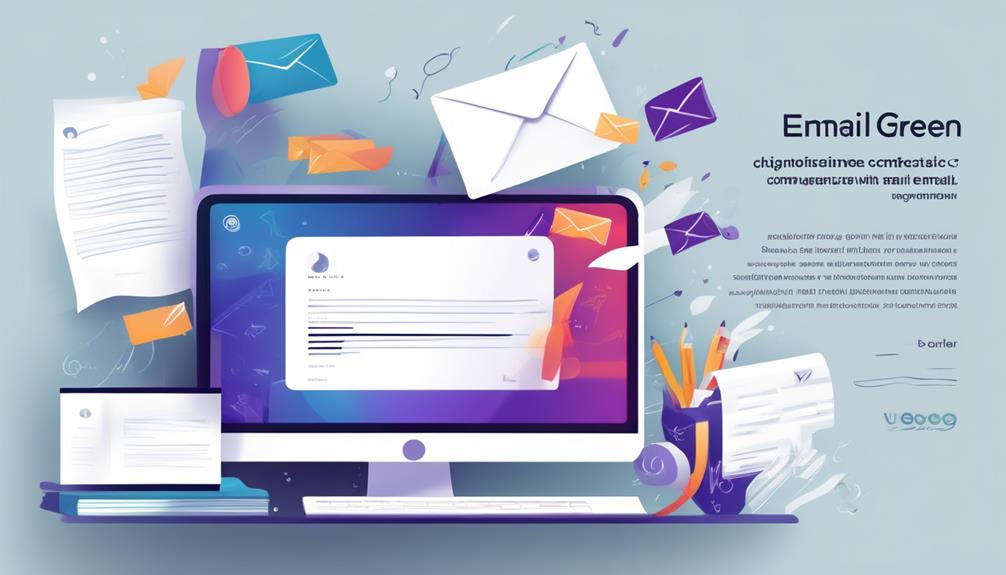When composing a professional email to a teacher, there’s a well-known saying that strikes a chord with most of us: “You never get a second chance to make a first impression.” But, what actions can we undertake to ensure our email leaves a positive and lasting impact?
Well, there are a few key elements that can make all the difference. Whether it’s crafting a clear and informative subject line, or striking the right tone, there are essential tips to consider.
So, let’s explore the art of composing an effective and professional email to a teacher and the impact it can have on our academic journey.
Key Takeaways
- Crafting a clear and concise subject line is essential for efficient communication with teachers.
- Using a proper salutation and addressing the teacher formally sets a respectful tone in the email.
- Structuring the email like a formal letter with an introduction, body, and conclusion helps maintain professionalism.
- Providing only essential information, using bullet points or numbered lists, and double-checking for spelling and grammar errors contribute to a concise and effective email.
Clear Subject Line
Crafting a clear and concise subject line is essential when composing an email to a teacher, as it enables efficient communication and ensures that the purpose of the email is easily understood.
When addressing formal emails to teachers, it’s important to be clear and specific in the subject line to convey the main point of the email. We must always keep timing in mind and consider that teachers often receive numerous emails daily.
Using subject lines such as ‘Question about Assignment Due Date for English Class’ or ‘Request for Extra Help with Algebra Homework’ ensures that the purpose of the email is immediately apparent. This approach helps teachers prioritize and address emails efficiently, ultimately leading to a more positive and productive communication experience.
Additionally, including appropriate salutations and double-checking email addresses to avoid any spelling mistakes further contributes to the professional and respectful tone of the email.
Appropriate Greeting

When addressing a teacher in an email, it is essential to begin with a proper salutation, such as ‘Dear Mr./Ms./Mrs. [Last Name],’ to convey respect and professionalism. Using the teacher’s professional title when greeting them is important to maintain formality. It’s crucial to double-check the spelling of the teacher’s name before sending the email to avoid any errors. Beginning your email with a formal and respectful greeting sets the tone for the rest of the communication. It’s important to avoid using casual language or informal greetings in your email to the teacher as it may come across as disrespectful or unprofessional.
| Do’s | Don’ts |
|---|---|
| Use ‘Dear Mr./Ms./Mrs. [Last Name]’ | Use informal greetings like ‘Hey’ or ‘Hi [First Name]’ |
| Address the teacher with their professional title | Use only the teacher’s first name without a title |
| Double-check the spelling of the teacher’s name | Use nicknames or abbreviations in the salutation |
| Begin your email with a formal and respectful greeting | Use slang or colloquial language in the greeting |
Formal Structure
After establishing the appropriate greeting in our email to a teacher, we proceed to maintain a formal structure that conveys professionalism and respect.
When starting an email, it’s crucial to use a clear and specific subject line that indicates the purpose of the email. This helps the teacher understand the content and priority of your message.
Address the teacher formally using their full name, such as ‘Dear Mr./Ms./Mrs. [Last Name].’ This shows respect and professionalism.
Additionally, structure your email like a formal letter, with an introduction, body, and conclusion. This ensures that your communication is organized and easy to follow.
Keep the email brief and to the point, including only necessary information. Teachers often receive numerous emails, so being concise is appreciated.
Lastly, always end the email with expressions of gratitude or appreciation. This shows politeness and leaves a positive impression.
Concise Information

To ensure clear and concise communication in our email to a teacher, it’s important to provide only essential details and avoid unnecessary information. When writing to a teacher, it’s crucial to respect their time by getting straight to the point.
In the subject line, clearly state the purpose of the email, such as ‘Request for Help with Assignment’ or ‘Meeting Request to Discuss School Project.’ This helps the teacher understand the nature of the email before even opening it.
In the body of the email, organize the content using bullet points or numbered lists to present information in a clear and structured manner.
When addressing the teacher, use their formal title and surname, such as ‘Ms. Smith’ or ‘Mr. Johnson,’ to maintain a professional tone. Additionally, always include a polite greeting and closing to show respect.
Before sending the email, double-check for spelling, grammar, and clarity to ensure that the message is professional and error-free.
Respectful Tone
We aim to maintain a respectful and professional tone when addressing our teacher, using a proper salutation such as ‘Dear Mr./Ms./Mrs. [Last Name]’ to convey our message effectively. When writing an email to our teacher, it’s essential to use formal language and maintain a respectful tone throughout the email.
This includes addressing the teacher as ‘Professor’ or ‘Mr./Ms./Mrs. [Last Name]’ rather than using their first name. Additionally, we should clearly state the purpose of our email in the subject line, including our name and the specific topic.
It’s important to provide all necessary context and information while keeping the email brief and concise. We also need to express gratitude and appreciation at the end of the email, showing our respect for the teacher’s time and attention.
Frequently Asked Questions
How Do You Start a Formal Email to a Teacher?
We start a formal email to a teacher by using a clear and specific subject line.
We address the teacher with a polite and formal greeting.
We should be concise and clear in our message.
It’s important to end the email with our full name, class, and institution.
We should always express gratitude for their time and assistance.
Double-checking the spelling of the teacher’s name is crucial.
Following proper email etiquette throughout the email is also important.
How Do You Start a Professional Email?
We start a professional email with a clear and formal greeting, a specific subject line, and concise, polite language.
It’s important to address the recipient respectfully and express gratitude at the end.
We proofread for clarity and correctness before sending.
This approach ensures professionalism and respect in our communication.
How Do You Start a Message to a Teacher?
Starting a message to a teacher is like crafting a thoughtful letter. We ensure it begins with a respectful salutation and a clear purpose. Politeness and conciseness are crucial, maintaining a professional tone throughout.
We express gratitude at the end, recognizing the value of the teacher’s time and help. This thoughtful approach sets a positive tone for the communication and reflects our commitment to professionalism.
How Do I Write an Email to My Child’s Teacher?
When we write an email to our child’s teacher, we ensure it’s clear and respectful. A detailed subject line includes our name, class, and the specific assignment if needed.
We greet the teacher with ‘Dear Mr./Ms./Mrs. [Last Name]’ and maintain a formal structure. It’s crucial to be brief and always thank the teacher for their time and assistance.
We proofread for spelling, grammar, and tone before hitting send.
Conclusion
In conclusion, writing a professional email to a teacher is essential for effective communication. Remember to use a clear subject line, choose an appropriate greeting, and structure your email formally. Keep the information concise and respectful, and always proofread before sending.
Did you know that 86% of teachers prefer to receive emails from students in a professional and respectful manner? It’s important to show respect and consideration in all communication with teachers.










